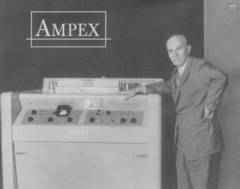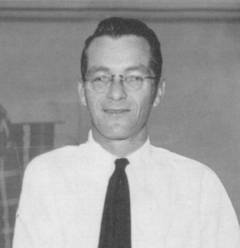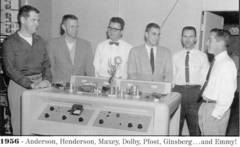Zum Auffrischen und Schmunzeln . . .
. . . sind diese Museums-Seiten hier gedacht, denn viele wissen nicht mehr oder noch nicht, wie es damals angefangen hat und wie das wirklich funktioniert mit den Tonband- und den Magnetbandgeräten aus alter Zeit. Viele Bilder können Sie durch Anklicken vergrößern, auch dieses.
Der Chef von AMPEX : Alexander Michael Poniatoff
As a boy in turn-of-the-century Russia, Alexi dreamed of steam locomotives. His father, a prosperous lumberman in Kazan provence, recognized his son's emerging engineering talent and made arrangements to send him, first to a Special high school and later to the technical academy in Karlsruhe, Germany.
Young Poniatoff had planned to use his education to build a turbine engine factory back home, but he was trapped by the outbreak of World War I. He managed to return to Russia where he enlisted in the army for pilot training. But he was soon trapped again, this time by civil war. He escaped to China where he worked for the Shanghai power Company until he could immigrate to the United States in 1927.
He was in demand as an experienced electrical engineer, moving from GE to PG&E to Dalmo-Victor during World War II. There, he developed a line of motors and generators for airborne radar. At the end of the war, Poniatoff founded his own Company using his initials, plus "ex" for "excellence" = AMPEX. (Some roumors said, "ex" was for expensive or early exchange, but that were roumors only.)
Needing new (after world war II) products to keep the Company going, he invested in magnetic recording by accident, meeting Bing Crosby and Jack Mullin, hiring Harold Lindsay to design heads for the new tape recording machine (as a clone of the German AEG magnetophone K4). As Company expertise increased in 1949, he brought aboard Charles Ginsburg, Ray Dolby, Charles Anderson, Fred Pfost, Alex Maxey and Shelby Henderson, who worked on the next goal, the television magnetic tape recorder/ reproducer.
The 1956 introduction of video tape recording established Ampex as the inno-vator of this explosive new industry Alex Poniatoff's quest for excellence became the Company's philosophy as it became world leader in audio and video recording, magnetic tape, digital and analog data handling and sophisticated memory products.
He served as president until 1955, when he was elected chairman of the board. In 1970, he was named chairman emeritus and continued to work with several foundations undertaking research in health and preventive medicine. Alexander M. Poniatoff died on October 24, 1980 at Stanford Medical Center in Palo Alto. He was 88.
Die Denkmaschine : Charles P. Ginsburg
Ginsburg's (some people called him Charlie Ginsberg) philosophical reminder "Timing is Everything," was more than a bon mot. He was diagnosed with juvenile diabetes at the age of six, the year lifegiving insulin became available for sufferers of this usually fatal malady. Not only did he survive the early hit-and-miss attempts at dos-age adjustment, but went on to aid both medical and public understanding of this disease with his personal involvement in the Juvenile Diabetes Foundation.
A Bay Area kid, he developed a keen love of golf and generally tried to position himself where the greens were good and the traps were kind. He obtained his masters degree in mathematics at San Jose State, then took a Job as transmitter engineer at KTTW, which later become KCBS, in Marin county.
In 1951, in the light of growing attention given to Ampex Corporation following the introduction of tape recording in radio broadcasting, young Ginsburg was determined to join this dynamic company even though he had no management or television experience, Charlie impressed the staff and was soon tapped to organize the project investigating the rotating head approach to magnetic video recording.
It was to take four years of hard work by a team of individuals who brought their own unique skills to the endless problems the project demanded - Ray Dolby, Charlie Anderson, Alex Maxey, Fred Pfost and Shelby Henderson. The historic first broadcast via tape of the November 30, 1956 airing of "Douglas Edwards and the News" on CBS, launched the multibillion dollar video industry.
Charlie Ginsburg met the challenge of leadership when it was needed, and he continued to be a major force in the refinement of video Standards at Ampex for the next 35 years. He retired as Vice President of Advanced Technology Planningand moved to Oregon where he died in April, 1992.
Robert W. Day
Growing up in Depressionweary Oakland, California, Bob Day worked a variety of Jobs to help the family but he soon found he had an unusual gift for radio. Even as a young man, his rich bass voice commanded attention and his ability to "rip-and-read" with ease, moved him ahead of more senior announcers.
A familiar figure in Bay Area radio during the 1950s, he hosted KGO's "San Francisco Sketchbook," and later the populär "Success Story" series on live television. After that show's Ampex episode, he was lured away from broadeasting to introduce the video tape recorder with a nationwide tour in the "Ampex Video Cruiser," a 40-ft custom bus with cameras, the video tape machine, a crew of ten people and five-thousand vacuum tubes.
As the voice of Ampex, Bob Day continued as corporate story-teller, using television produced on video tape -"teleproduction"- on and off the Ampex campus for the next 35 years. Many of today's production techniques were pioneered a quarter-century ago by Day trying to tell a fresh story in the competition- charged cauldron of NAB's four-day grind. Techniques such as interactive video, quick-cut editing, synchronized multi-screen presentations... were pioneered in analog with just a typewriter, a stopwatch and what George Bush would later call, "the vision thing!"
His brand of story telling, which began on radio as just a voice in the dark, went on to illuminate television's transition from "staged" to "stored" images. It is widely acknowledged that Bob Day's work influenced other creative minds to enrich the vocabulary of video production.
On June 28, 1994, he died peacefully in his sleep. He was a loyal friend, a good guy who suffered fools with compassion. He never missed a cue and he always knew his lines.
This tribute to our friends and colleagues celebrates a triumphant time and acknowledges the continuing contributions made by Ampex alumni, everywhere. Our thanks to Tom Washburn and Pete Hammar for their assistance.




